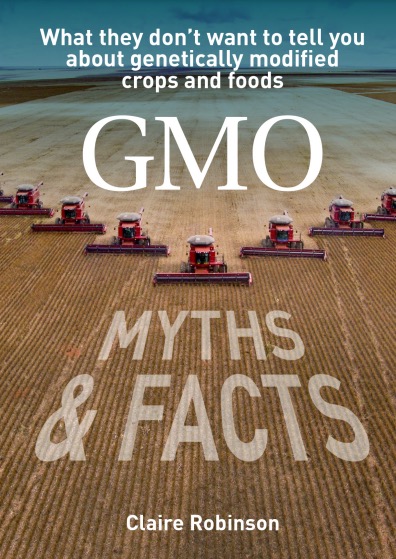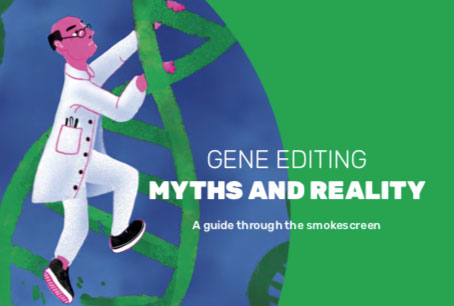Damage to DNA is 44% higher than in unexposed children. Claire Robinson reports
Children exposed to pesticides sprayed in a GM soy-producing region of Argentina have genetic damage, a team of researchers from the National University of Río Cuarto, Cordoba (UNRC), found in a new study.
The study compared 50 children living in the town of Marcos Juárez (Córdoba) at different distances from pesticide-sprayed areas with 25 children from the city of Río Cuarto (Córdoba), who were considered not to be exposed to pesticides.
Genetic damage in the group of exposed children in Marcos Juárez was 44% higher than in the unexposed children in Río Cuarto.
The most commonly used pesticides in the region are glyphosate, cypermethrin, and chlorpyrifos.
A significant difference was found between exposed children living less than 500m from areas subjected to spraying and those who were not exposed. Forty percent of exposed children suffered some type of persistent condition, which may be associated with chronic exposure to pesticides.
Of the exposed children, 20 (40%) had varying persistent symptoms, such as repetitive sneezing, respiratory distress, cough, bronchospasm, skin itching or stains, nose itching or bleeding, lacrimation, and eye and ear burning or itching. None of the children who had not been exposed described any persistent symptoms.
The level of genetic damage detected in this experiment is reversible, so the authors suggested that the children should be followed up to establish whether biological markers of cell damage continue to be present.
The study was conducted by Delia Aiassa, Fernando Mañas, Natalí Bernardi, Natalia Gentile, Álvaro Méndez, Dardo Roma, and Nora Gorla. All are members of the Genetic and Environmental Mutagenesis Group (GEMA) at the Department of Natural Sciences Faculty of the UNRC.
The lead researcher, Delia Aiassa, said she chose to study children because they are still developing, and genetic damage at this age can influence their health as adults.
"Among the adverse effects that can be studied in children exposed to various environmental hazards, cytogenetic damage [damage to the structure and function of the cell, especially chromosomes] received special attention after it was shown that increased frequency of DNA damage to chromosomes in childhood is predictive of the development of cancer in adults," Aiassa said.
Aiassa said that environmental effects that may arise many years, even decades, after exposure, can be monitored in childhood through cytogenetic studies.
She warned that in adult monitoring, one of the difficult problems to overcome is the effect of confounding factors that interfere with the analysis of the results, such as smoking, alcohol consumption and occupational risk. She stressed that these confounding factors are minimized or even absent in childhood.
Nonetheless, children whose parents or relatives were smokers, consumed coffee or tea in excess, used medication for chronic diseases, had been exposed to X-rays in the past 6 months, or had been exposed to contaminants in drinking water or to other environmental pollutants close to their place of residence, were excluded because they were considered confounding factors.
The researchers concluded, “Evidence of the effects of environmental exposure at an early age is so strong that all possible efforts should be made to eliminate such exposures in pregnant women and children, to protect their present and future health.”
Sources
Media article in Spanish: http://www.lavoz.com.ar/ciudadanos/unrc-detectan-dano-genetico-en-ninos-expuestos-plaguicidas
Study in English: http://www.scielo.org.ar/pdf/aap/v113n2/en_v113n2a09.pdf
—
Assessment of the level of damage to the genetic material of children exposed to pesticides in the province of Córdoba
Natalia Gentile, B.S., Fernando Mañas, M.D., Álvaro Méndez, M.D., Nora Gorla, M.D., and Delia Aiassa, M.D.
Arch Argent Pediatr 2015;113(2):126-132
http://www.scielo.org.ar/pdf/aap/v113n2/en_v113n2a09.pdf
ABSTRACT
Introduction.
In the past decades, several authors have investigated the genotoxicity caused by exposure to chemicals, but there are no reports on studies analyzing such effects on children in Argentina. The objective of this study was to establish the micronucleus frequency in exfoliated buccal mucosa cells in children from urban areas with environmental exposure (through inhalation) and to compare it with the micronucleus frequency in children from urban regions far from areas subjected to spraying.
Population and Methods.
Fifty children living in the town of Marcos Juárez (Córdoba) at different distances from pesticide spraying areas and twenty-five children from the city of Río Cuarto (Córdoba), who are considered not exposed to pesticides, were studied; the micronucleus assay in buccal mucosa cells was used.
Results.
A significant difference was observed between exposed children living less than 500m from areas subjected to spraying and those who were not exposed. Forty percent of exposed children suffer some type of persistent condition, which may be associated with chronic exposure to pesticides.
Conclusions.
Results indicate that genotoxicity is present in a group of children compared to the other one, and highlight the importance of the micronucleus assay in buccal mucosa cells for genetic biomonitoring and public health surveillance. This assay is capable of detecting a level of damage that can be reversible.









